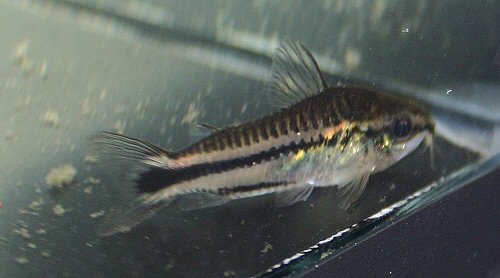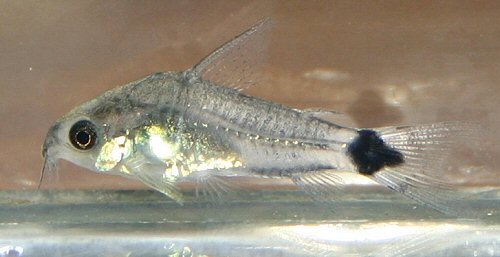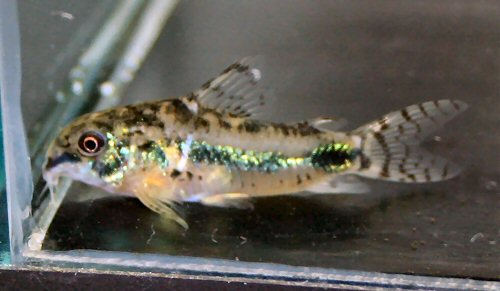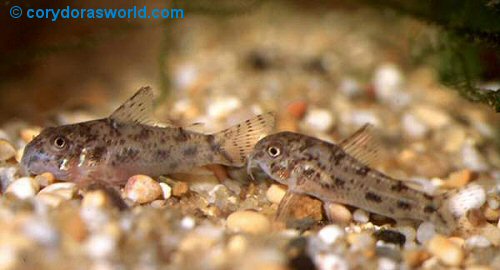 here
are numerous species of Corydoras available
to the hobbyist, many of which have been described for
years, some of which have only recently been discovered
and are awaiting identification and subsequent naming.
I think that this is something which will always fascinate
me, the fact that there are new species potentially
awaiting discovery from remote corners of the South
American continent. here
are numerous species of Corydoras available
to the hobbyist, many of which have been described for
years, some of which have only recently been discovered
and are awaiting identification and subsequent naming.
I think that this is something which will always fascinate
me, the fact that there are new species potentially
awaiting discovery from remote corners of the South
American continent.
The thing that concerns me personally
however, is the rate at which the rain forests are disappearing,
which not only impacts upon the natural habitats of
these wonderful catfish and the associated other forms
of fauna and flora, but also upon us the human population
as well. With all the doom and gloom surrounding climate
change I wonder how long it will be before the situation
reaches its conclusion, and where all life will feature?
As many of you are aware I have been fortunate enough
to visit the Amazon and some of its many tributaries
in order to observe some of our aquarium fishes natural
habitats, which will form part of some future articles.
It is my intention to cover some
of the often overlooked species of Corydoras
- the ‘dwarf’ or ‘pygmies’ as
many aquarists refer to them as. I have kept many species
of Corydoras and to this day still find them
very fascinating to watch and observe. As you are most
likely aware Corydoras belong to the family
Callichthyidae, sub-family Callichthyinae, which also
includes the genera Aspidoras, Brochis,
Dianema, Hoplosternum, Lepthoplosternum,
Megalechis and Scleromystax, and just
to keep us on our toes the taxonomists like to cause
more confusion when they review the families as has
happened during recent years. This has resulted in some
species of Corydoras being reclassified as
Scleromystax. I guess that it is this confusion
within taxonomy, as well as the observations made over
many years which makes this family of catfish so interesting
and fascinating to keep.
When keeping these catfish the
following information might be of use especially to
those of you venturing into keeping Corydoras for
the first time:
Water parameters
– Corydoras prefer
to be kept in water which has a pH in the range of 6.0-7.2,
and hardness in the range of 2-25°dGH. This catfish
is ideally suited to temperatures in the range of 23-27ºC
or 73-81ºF.
Feeding
– As with all the other catfish that I have had
the pleasure to keep over the years, Corydoras readily
accepts a mixed and varied diet which includes granular
foods, frozen bloodworm and good quality flake to name
but a few. Due to the relatively small size of these
catfish I would suggest that the dry foods offered are
slightly crushed to make them smaller for these fish
to eat.
Aquarium size
– I would suggest a minimum size of 18”
x 12” x 12” or 24” x 15” X 12”
for a small shoal of these catfish, with plenty of hiding
places amongst bogwood and rocks. These magnificent
tiny catfish might also be suitable for adding to a
‘Nano’ type aquarium in smaller numbers.
The ideal aquarium substrate to use with these catfish
is aquarium sand such as BD Aquarium Sand. As with all
other species of fish, water quality and general husbandry
is very important, and I would recommend that a minimum
of 25% water is changed on a weekly basis.
Compatibility
–Wherever possible I would recommend that the
aquarist keep these catfish in a community aquarium
in small groups of six or more, but as the absolute
minimum I would suggest three specimens. In their natural
habitat Corydoras would be found in relatively
large shoals.
Sexual differences
– The males tend to be more slender than the females.
Breeding
– There are numerous documented reports of aquarium
spawnings of Corydoras. The majority of Corydoras
adopt the typical “T shape” breeding clinch
when spawning. The spawning activity follows on from
a period of conditioning with foods such as Daphnia
and bloodworm, and a partial water change using cooler
water, which replicates the lead up to the rainy season
in their natural habitats – the trigger for breeding
activity to take place.
For the purpose of this article
I have documented four species of Corydoras which
do not attain lengths above 40mm standard length which
is the measurement from the tip of the snout to the
base of the caudal peduncle. All sizes quoted are in
mm standard length.

Corydoras
pygmaeus –
Knaack, 1966
Common Name – Pygmy Cory
Natural Habitat – South America
namely Brazil, Est. Rondônia, surroundings of
Calama, along Rio Madeira near the mouth of Rio Jipiraná
(Rio Machado). Also found in Ecuador, Napo Province,
Rio Aguarico, Peru, Loreto Province, and Rio Nanay near
Iquitos.
Size – Males 25mm & females
32mm
Body – Typical triangular body
shape with the head being short and compact.
Colour – Base colour of head
and body grey/green. Blackish coloured line running
from the tip of the snout through the junction of the
body scutes ending at the caudal peduncle, where it
broadens out into a triangular shape. Dorsal parts of
dorsolateral body scutes with darker pigment on the
posterior edges. Ventrolateral body scutes are creamy
white with the exception of a dark line which runs from
the ventral fins to the anal fin. All fins are described
as being clear.
Remarks – This species is often
mistaken for Corydoras hastatus within the
aquatic trade. Corydoras pygmaeus lacks the
lozenge-shaped blotch at the root of the tail along
with the white to yellowish coloured margin above and
below. This species sports a black band that runs the
full length of the body, ending just short of the tail
end, and ending in a slightly broader band when compared
to Corydoras hastatus.
Etymology – Cory meaning helmeted,
doras meaning leathery skin (helmeted Doras) cuirass.
Pygmaeus from Latin meaning dwarf.

Corydoras
hastatus –
Eigenmann & Eigenmann, 1888
Common Name – Dainty Corydoras
Natural Habitat – South America
namely Brazil, Est. Amazonas, Villa Bella, Parintins.
It is suggested that this locality is doubtful as there
are several Villa Bellas (Vila Bela) in Brazil and the
species is common within the Rio Paraguay drainage in
Brazil and Paraguay
Size – Males 25mm & females
32mm
Body – Typical triangular body
shape with the head being short and compact. The dorsal
fin has 1 hard ray and 7 soft rays. The anal fin has
2 hard rays and 5-6 soft rays. There are 22 bony scutes
in the upper lateral series and 20 in the lower lateral
series.
Colour – The base colour of the
body and head is grey-green to golden yellow. The back
is olive green; the flanks are yellowish with a whitish
coloured belly. The head, body and fins are sprinkled
with small dark spots. A black longitudinal band runs
from behind the gill cover to a lozenge-shaped blotch
at the root of the tail; the latter blotch having a
white to yellowish coloured margin above and below.
A second broader streak runs along the lower edge of
the caudal peduncle. The fins are dull grey. The base
of the caudal fin is blackish in colour.
Remarks – This species is said
to prefer a specific habitat which is called the ‘swimming
meadows’ of the Pantanal and Choco region. In
its natural habitat this catfish is generally found
in small groups of 15-20 specimens. There is a characin
– Serrapinnus kriegi which closely resembles
this catfish and is often found in amongst shoals of
the catfish. This is a very small mid-water shoaling
species, which does not spend as much time on the substrate
as other species do, preferring to sit on the leaves
of aquarium plants rather than sitting on the substrate.
Etymology – Cory meaning helmeted,
doras meaning leathery skin (helmeted Doras) cuirass.
Hastatus from Latin meaning armed with a spear.

Corydoras
habrosus –
Weitzman, 1960
Common Name – Dwarf Corydoras
Natural Habitat – South America
namely Venezuela, State of Cojedes, Rio Salinas, tributary
of Rio Pajo Viejo, El Baúl.
Size – Males 32mm & females
35mm
Body – Typical triangular body
shape with the head being short and compact. The dorsal
fin has 1 hard ray and 7 soft rays.
Colour – Base colour of head
and body pale tan. There are three dark blotches along
the middle of the body, the first below the dorsal fin,
the second between the dorsal and adipose fins; the
third and darkest blotch is on the caudal peduncle.
The three azygous scutes before the adipose fin have
dark pigment on them. There is scattered dark pigment
on the dorsolateral body scutes, the ventrolateral body
scutes are without pigment except for the upper portions
of those scutes associated with the three dark midside
blotches. The dorsal fin is clear except for two dark
rows of fine spots. The adipose fin membrane is clear
with some dark pigment on the spine. The caudal fin
has four light rows of spots in the upper lobe and three
in the bottom lobe. The pectoral, ventral and anal fins
are clear.
Remarks – Some older aquatic
literature refers to this species as Corydoras cochui,
sharing a similar colour pattern. Corydoras cochui
has a more slender body than Corydoras habrosus
and one more blotch on the side of the body. Corydoras
habrosus has no spot at the base of the ventral
fin, and the pectoral fins are not barred.
Etymology – Cory meaning helmeted,
doras meaning leathery skin (helmeted Doras) cuirass.
Habros from Greek meaning pretty, delicate or dainty.

Corydoras
cochui –
Myers & Weitzman, 1954
Common Name – Pygmy Catfish,
C022, Barred-tail Corydoras, Cochu’s
Catfish.
Natural Habitat – South America
namely Brazil in the Upper Araguaia River basin. Also
documented as being found in the Rio Araguaia, Santa
Maria Nova and State of Goyaz (Goiaz).
Size – Males 30mm & females
35mm
Body – Slender with a rounded
snout, although it does still have the typical triangular
appearance which makes this family distinct.
Colour – Base colour of body
and head is light brown. There are four dark coloured
blotches along the flanks; one below the dorsal fin,
one between the dorsal and adipose fin, one below the
adipose fin and one on the caudal peduncle. There is
a dark streak along the back of the fish which extends
from below the dorsal fins spine, ending in a dark spot
on the upper edge of the caudal peduncle. The top of
the head is dark in colour which continues just below
the eye. The upper and anterior portion of the opercle
is also dark in colour. The caudal fin has five narrow
irregular dark coloured cross bands. The base of the
anal fin has a dark coloured spot extending into the
body. Ventral fin is clear. Pectoral fin rays with a
few dark coloured scattered spots. Dorsal fin rays with
a scattering of dark coloured spots forming two irregular
rows. Dorsal and pectoral fin spines having a narrow
dark line along them.
Remarks – This particular species
is not commonly available, but is well worth looking
out for and is ideal for smaller aquariums.
Etymology – Cory meaning helmeted,
doras meaning leathery skin (helmeted Doras) cuirass.
Cochui named in honour of Mr Fred Cochu.
In addition to those
species detailed above the excellent book - Identifying
Corydoradinae Catfish by Ian Fuller and Hans-Georg Evers
mentions the following two species, which to date I
have not had the pleasure to see for sale:
Corydoras
paragua - Knaack, 2004. A species
from Bolivia. Males attain a length of 35mm, and females
40mm.
Corydoras multimaculatus
- Steindachner, 1907. A species from Brazil. Males attain
a length of 35mm, and females 40mm.
The next time you are looking
to purchase some smaller fish spare a thought for these
miniature catfish, you will not be disappointed!
Glossary of terms:
Caudal is defined as the tail
fin.
Pectoral fins
are defined as paired lateral fins.
Dorsal fin is
defined as the medial fin on top of the back.
Adipose
is defined as a second dorsal fin which in the case
of Corydoras consists of fatty tissue with
a single spine supporting a thin membrane.
Dorsal
is defined as being top or above.
Ventral
is defined as bottom, below or underneath.
Opercle
is defined as the large bone forming the gill cover.
Caudal peduncle
is defined as the usually narrowing posterior part of
the body between the anal and caudal fins.
Scute
is defined as a bony plate.
Dorsolateral
is defined as extending from the top to the side.
Ventrolateral
is defined as extending from below and to the side.
References:
Catfish Association Great Britain –
Volume 1
Catfish Association Great Britain –
Information Book 6
Identifying Corydoradinae Catfish –
Ian Fuller & Hans-Georg Evers
www.fishbase.org
www.planetcatfish.com
www.scotcat.com
All Image's by Author
apart from Corydoras cochui which is credited
to Ian Fuller of www.corydorasworld.com
|





